Basketball
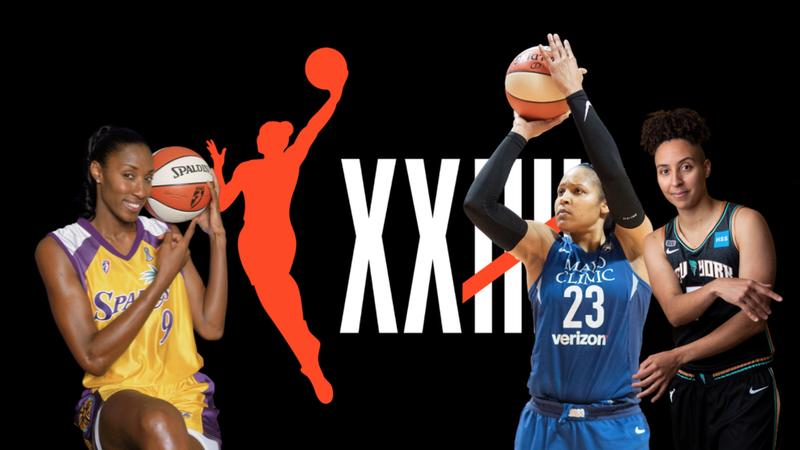
Founded on April 22, 1996, the Women's National Basketball Association (WNBA) was first conceptualized equally a counterpart to the men's National Basketball Association (NBA). In fact, ahead of its inaugural flavor in 1997, the WNBA centered its marketing campaign effectually the phrase "We Got Next." The slogan had a literal pregnant; that inaugural picked up just afterward the NBA's season wrapped, but it also indicated something more. "It's the three-give-and-take ticket to play in street-corner basketball," Alison Roberts wrote in The Sacramento Bee 25 years ago. "At long last, information technology'south now the women'due south plow to say it — and to play information technology."
Over two decades after, the WNBA has carved out its own reputation as a premier professional sports league replete with scores of talented players, from greats of the past, like Rebecca Lobo, Lisa Leslie and Sheryl Swoopes, to some of today's about decorated athletes, like Candace Parker, A'ja Wilson, Breanna Stewart and Sue Bird. 1 of league'southward more recent mottos was "Picket Me Work," a notion that extends across the boundaries of a basketball court and into the realm of league-wide social justice initiatives.
To mark the league'due south 25th year, we're taking a look back at the WNBA's origins, standout moments and exciting future ahead of this season's first weekend of games.
College Basketball Helped Garner Enthusiasm for the Creation of the WNBA
When yous think of college basketball, there's a good gamble the University of Connecticut comes to mind. And, well-nigh likely, you're thinking of the women of UConn, who, alongside long-time double-decker Geno Auriemma, have consistently pushed the game to new heights. Simply there was a time when the dynasty wasn't known for breaking records or shaping some of the greatest basketball game players of all time. In fact, UConn'due south now-iconic legacy actually took shape in 1995.
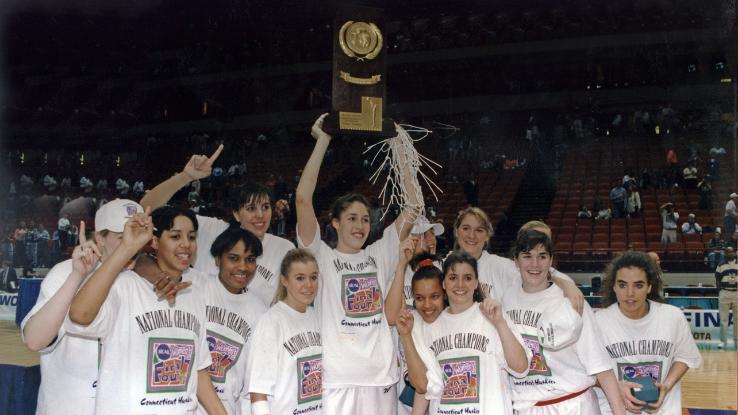
Just over 25 years agone, the Huskies had an all-star team led past greats like Jamelle Elliott, Jennifer Rizzotti, Kara Wolters, Nykesha Sales and, of course, Rebecca Lobo. During regular flavour play, the '94-95 Huskies dethroned the seemingly insurmountable (and and then-No. one) Tennessee, which helped the squad clinch an undefeated season. The first 35-0 flavor record in National Collegiate Athletic Clan (NCAA) history is reason enough to celebrate, right? Well, UConn did one meliorate when March Madness rolled around by winning their first national title. And, to do so, they once again defeated Tennessee.
While UConn's win was monumental for the program, the reverberations extended far beyond Storrs, Connecticut. "Two years after the title, Lobo became a pillar of the newly created WNBA," Alexa Philippou wrote in the Hartford Courant, "a league whose very existence owed in function to how the '95 Huskies inspired the country to cover women's basketball in a fashion it hadn't before."
The Women'due south National Team Changed Everything at the 1996 Olympic Games
Togethxr, a new, women-led media venture founded past Chloe Kim, Sue Bird, Simone Manuel and Alex Morgan, is producing a six-role documentary podcast series, called Summertime of Gold, about this very Olympics. Bird, one of the pod's hosts, has even credited the '96 Games with, amongst other things, launching the WNBA. So, while UConn'south nationally televised and then-underdog victory was momentous, it wasn't the only slice of the puzzle.
Equally longtime fans will think, the 1995-96 Women's National Team had a real watershed moment at the '96 Olympics Games in Atlanta, Georgia. Fifty-fifty U.s.A. Basketball is quick to point out that "[the national team] had seen its authority in the international game wane," and, undoubtedly, there would be no better fourth dimension for the team to reassert themselves than on the "habitation courtroom" of a world phase.
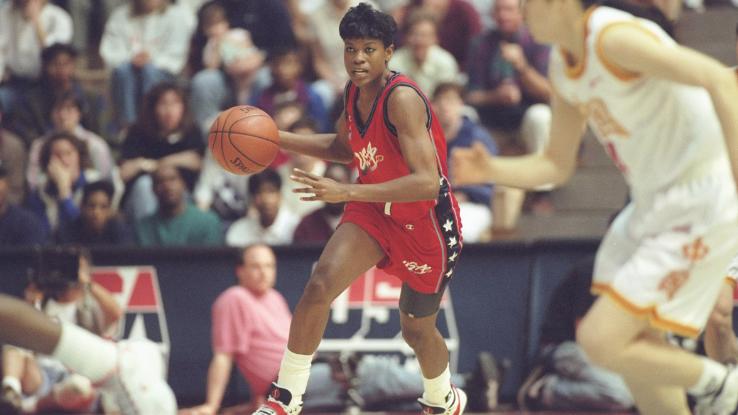
Implementing a more than rigorous grooming plan than ever earlier was a must. Not but because U.s.a.A. Basketball game wanted to clinch the gilt medal, just because the association had "adopted a secondary goal of elevating the popularity and visibility of women'due south basketball throughout the U.South."
To prep its Olympic squad, U.S.A. Basketball game mapped out a 52-game schedule: The shortly-to-be Olympians would face off against top NCAA programs also as international teams. This landmark training regimen as well gave fans the chance to see pro basketballers in activeness. For example, the squad's game against UConn drew a crowd of 8,241 attendees — an impressive stat because that it was only an exhibition game.
By the time the Olympics rolled effectually, the gold-medal momentum was there. "It was a schoolhouse-daughter level of excitement," U.S. National Team Director Carol Callan recalled in a 2016 interview with ESPN. "People were screaming on the bus. They'd been playing and grooming together for a year, and it was time to see the end result." In fact, the '95-96 National Team ended their run with an impressive 60-0 record — 52 pre-Olympic wins and viii victories at the games, all of which amounted to the team earning the golden.
"There's never been a more than ascendant team in the Olympics in any sport than the U.Southward. women's national team," UConn's Auriemma, who has since coached several gold-medal national teams at the Olympics, told ESPN. Without a doubt, the team's victory in Atlanta launched the careers of several at present-legendary players — Leslie, Lobo and Swoopes — only it besides changed the unabridged mural of women's basketball game, creating enough momentum to spawn two pro leagues, ane of which had the NBA's bankroll.
The Early Days of the WNBA
When the WNBA was appear, some other professional person league, the American Basketball League, also cropped upward. Unfortunately, that league, which began play a year earlier the WNBA in 1996, would shutter during the '98-99 season, but the fact that women's basketball had enough momentum behind information technology to sprout two leagues remains impressive. Back in '97, the WNBA was comprised of eight teams:
- Charlotte Sting
- Cleveland Rockers
- Houston Comets
- New York Liberty
- Los Angeles Sparks
- Phoenix Mercury
- Sacramento Monarchs
- Utah Starzz
And, with the full backing of the NBA, information technology managed to clinch a number of well-known players, including Leslie, Lobo and Swoopes — the first women's basketball player to become her own signature shoe. On June 21, 1997, the league held its outset game, which saw the New York Liberty taking on the Los Angeles Sparks in LA. In those early years, the Houston Comets dominated the league, winning championship titles in 1997, 1998, 1999 and 2000. The Comets' breakout star wasn't necessarily Swoopes, merely Cynthia Cooper-Dyke, who concluded upwardly being named the WNBA Finals MVP in all 4 of those winning seasons.
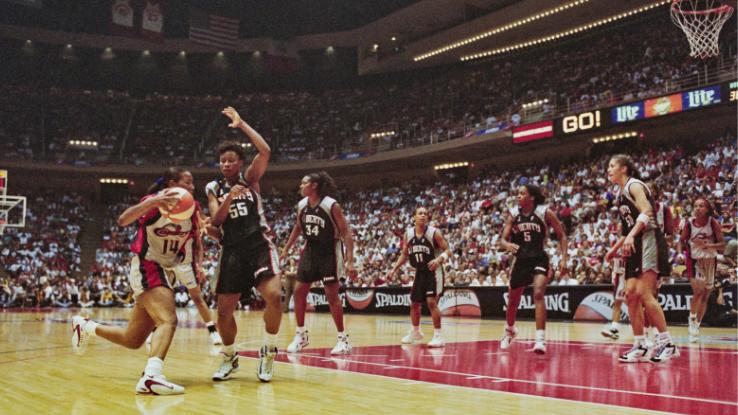
The WNBA Proves That Visibility Matters
Over the years, some teams have moved or disbanded, but, overall, the WNBA has expanded. Currently, the league'southward 12 teams are:
- Atlanta Dream
- Chicago Sky
- Connecticut Sunday
- Indiana Fever
- New York Liberty
- Washington Mystics
- Dallas Wings
- Las Vegas Aces
- Los Angeles Sparks
- Minnesota Lynx
- Phoenix Mercury
- Seattle Storm
Of these teams, ii are tied for the most championship titles: Both the Minnesota Lynx and defending champs Seattle Storm have won four. But the league has ever been well-nigh more than on-court victories, perhaps because professional athletes playing in leagues like the WNBA have ever had to continually "bear witness" themselves.
For i, at that place'due south the issue of accessibility — that is, game broadcasts aren't as easy to come up past every bit, say, NBA broadcasts. Fans might tune into ESPN, Twitch or CBS, or sign up for the WNBA's League Laissez passer to chase down games. In "(In)visibility," a 2016 essay for The Players' Tribune, quondam Lynx star Maya Moore discusses her frustration with the disconnect. "We need the marketing to friction match our product," Moore wrote. "Celebrate us for the things that matter — the stories, the basketball game, the character, the fiery competitiveness, our professionalism."
Non to mention, Moore should be every bit much a household proper noun equally Michael Jordan. Sports Illustrated has dubbed her the "Greatest Winner in [the] History of Women's Basketball game" — and for expert reason. Back when she played for UConn, Moore nabbed 2 NCAA titles and finished her higher career with a staggering 150 wins and just iv losses. That winning record connected in the WNBA, where she became a four-time champion and bonafide star of the Minnesota Lynx. "Visibility is nuanced and information technology can accept many forms, from organized youth leagues all the way upwardly to marketing and sponsorships on the professional level," Moore noted in her essay. "If we desire to grow the women'southward game, we've got to abound the visibility."
Moreover, in that location's the issue of equal pay, which, in a sort of cyclical fashion, relates to the marketing and visibility issues Moore wrote nearly. With Seattle'southward 2020 victory, Sue Bird became the third person in WNBA or NBA history to win titles in three different decades. In fact, both she and NBA star LeBron James accept 4 championship titles nether their belts — simply that wouldn't exist clear if you looked at their pay. Equally NBCSports notes, "Fact is the average WNBA salary, slightly less than $100,000, is roughly 1.five percentage of the boilerplate NBA salary, which exceeds $vii one thousand thousand."
The WNBA Centers Activism & Uplifts Players
From Tommie Smith and John Carlos to Colin Kaepernick, athletes take e'er used their platforms and voices to bring visibility to causes and problems that exist beyond the boundaries of a field, courtroom or ring. Merely, over the last decade, the WNBA has taken athlete activism to the next level. What sets the WNBA autonomously? It'southward not just players who are using the platforms, but a concerted endeavor from all 12 teams.
In 2014, the WNBA became the starting time American pro sports league to openly marketplace to LGBTQ+ fans, hosting Pride nights and printing off rainbow merch. What was initially framed as rainbow capitalism has since evolved into something more than inclusive and genuine, thanks in large role to openly queer, trans and nonbinary players (and their allies) who are consistently using their platforms to promote change and amplify their own visibility.
In 2017, WNBA players Brittney Griner and Layshia Clarendon published an op-ed that opposed Texas Senate Bill 3 (SB3), which aimed to regulate bathroom access based upon one's "biological sex" and block local anti-discrimination bills that protect trans folks' rights to utilise the bath that matches their gender. Griner and Clarendon praised activist-athletes who paved the way for them, writing, "Every bit beneficiaries of such brave efforts, we do not take our responsibility equally activists lightly. We believe it is our moral duty to use the platform nosotros have been given to speak out."
By 2018, the WNBA's Take a Seat, Take a Stand helped heighten funds for GLSEN, an "education organization working to end discrimination, harassment, and bullying based on sexual orientation, gender identity and gender expression and to prompt LGBT cultural inclusion and sensation in K-12 schools" through Pride Night ticket sales. And the league is centering its queer players in a way other pro sports leagues simply aren't. From jubilant Sue Bird'southward recent engagement to soccer star Megan Rapinoe to uplifting Clarendon when they shared they're trans and nonbinary and underwent gender-affirming top surgery, the WNBA has helped foster visibility — and allowed fans to meet themselves in the players they love.
"We are so proud that Layshia is part of the WNBA and we know that their voice and connected advancement will not only support and help honour and uplift many other nonbinary and trans people," WNBA commissioner Cathy Engelbert wrote in an Instagram story, "only likewise encourage empathy and understanding for the community across all levels of sport."
In a recent Sports Illustrated story, "Living Nonbinary in a Binary Sports World," Clarendon reiterated the connection between sports, belonging and visibility, saying, "That feeling of belonging is invaluable as a young person. I loved the competitiveness of sports, chasing a goal, the esprit of being around teammates and how when I made a laissez passer to someone and they scored information technology felt like we could accomplish anything."
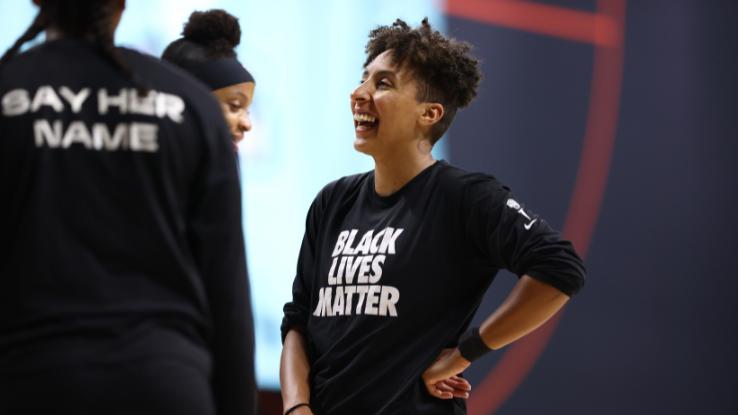
The WNBA Protests Constabulary Brutality & Racial Inequality
In September of 2016, the Indiana Fever WNBA squad joined other athletes — inspired by Colin Kaepernick — to kneel during the national anthem to protest ongoing police brutality against Black folks in America. But this protest was unique. The players took activeness just before a WNBA playoff game — a loftier-stakes issue with higher viewership — and every single member of the Fever knelt, arms linked. This marked the first time an entire squad in any pro sport protested during the anthem.
Just concluding twelvemonth, the WNBA showed solidarity again with Black Lives Affair and Black folks in the wake of the murder of George Floyd. Every bit protesters across the country fight against police brutality, the WNBA, and its teams and players, have added to the chat. "The time for change is at present. Enough is enough," the WNBA tweeted on May 29, 2020, along with a photo of empowerment that reads "Bigger Than Brawl." Only that wasn't where the solidarity ended.
With health risks and players' financial security accounted for during pandemic shutdowns thanks to the WNBA "bubble," the league could resume play over the summer — and remain at the forefront of change, especially when it comes to demanding racial justice. Nneka Ogwumike, forward for the Los Angeles Sparks and president of the Women's National Basketball Players Association (WNBPA), told The New York Times that the season could deed equally a platform for spotlighting activism, saying, "We've always been the first in line to speak near social issues, and we see this as a really magical moment for united states to turn the unexpected into something that could be very beautiful, with 144 voices in the aforementioned identify."
In July, WNBA players dedicated their season to Breonna Taylor and the Say Her Name campaign, which aims to bring awareness to Black women who are victims of police violence. In addition to wearing Taylor's proper noun on their jerseys for the elapsing of the season, players took some of the most radical actions in the pro sports world: Instead of kneeling for the national anthem, teams left the court for the duration of the song.
According to NPR, about seventy% of the players in the WNBA are Black, and it'south articulate that the league was ready to stand behind their players — and fans — and leverage the sport'due south immense platform for skilful. For years, the WNBA has been leagues alee of other professional sports leagues when information technology comes to pursuing societal modify and justice, and 2020 cemented the league's and players' places in history.
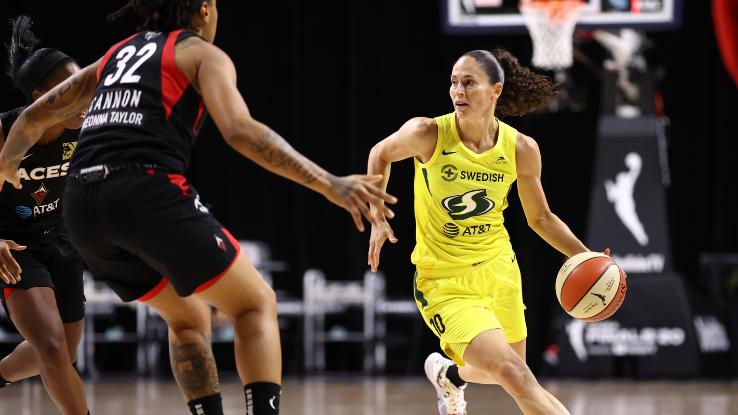
Everything You Demand to Know Nearly the 2021 WNBA Season
The 2021 WNBA flavour starts Fri, May xiv, with the Indiana Fever taking on the New York Freedom; the Connecticut Sun facing off against the Atlanta Dream; the Phoenix Mercury playing the Minnesota Lynx; and the Los Angeles Sparks and Dallas Wings wrapping things upwardly. After these season openers, games keep through the weekend, with the season running through September 19, 2021. From July 12 to August 14, the league will take a break for the Olympic Games.
Dissimilar terminal flavor, which saw teams attending a "bubble" in Florida to play pandemic-safe basketball, fans will be in attendance at this twelvemonth's game, though reduced capacities and mask-wearing will exist enforced. Additionally, teams will be playing slightly reduced 32-game seasons.
Since games are broadcast on a broad diverseness of networks — ABC, ESPN, ESPN2, CBS, CBSSN, NBA TV, Oculus and Twitter — fans should double-check where each game is bachelor. For those looking to watch this season's biggest match-ups and catch upwardly on last year'southward play, the WNBA League Pass may be the style to go. Not to mention, the league has redesigned the official WNBA ball just ahead of the 2021 season. And, while yous're browsing all the WNBA app has to offering, nosotros recommend checking out the latest limited-edition jerseys, all of which pay homage to the teams' hometowns and the rich history of the WNBA.
Source: https://www.ask.com/culture/wnba-at-25?utm_content=params%3Ao%3D740004%26ad%3DdirN%26qo%3DserpIndex
0 Response to "Basketball"
Post a Comment